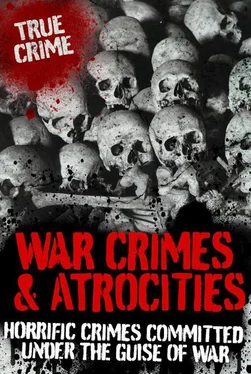AFTERMATH
After the war, the full extent of the suffering of the Greek people during the German occupation of Greece became clear. It was calculated that around 60,000 men, women and children lost their lives in massacres at the hands of the Nazi troops during the war years. Not only that, but the suffering continued when a bitter civil war erupted in Greece after the war, claiming thousands more victims. Hostilities only ended in 1949, when the communist-led Democratic army were defeated by the Hellenic army.
In 1960, the German government paid the Greek government a total of a 115 million marks as compensation for the war crimes committed during the occupation. In 1990, officials from the German embassy took part in a ceremony commemorating the victims of the massacre at Distomo, but to date no compensation has been made for them in particular.
Today, at the Mausoleum there, the skulls and bones of the victims are displayed for visitors, so that what happened on that fateful day in 1944 can never be forgotten. The history of the Nazi occupation of Greece is a shameful one, and it is important that the massacres and atrocities that took place there – both against the Italian soldiers and the Greek civilians – should be remembered, not only as an indictment of the Nazi regime, but of all forms of intolerance and hatred throughout history.
Russian Ethnic Cleansing and Other Atrocities
1939–49

During the years 1939–49 the Soviets, under the leadership of a powerful and dangerous dictator, Joseph Stalin, caused the suffering and death of millions of ordinary individuals. In fact, Stalin may be responsible for more intentional human slaughter than any other single human being in recorded history. His dream was to have a powerful industrial state which he tried to fulfil with a callous disregard for human life. His victims were either executed or imprisoned in labour camps that turned out to be little better than ‘death’ camps.
UNTOLD HORROR
By 1928, Stalin had established himself as a supreme leader and he wasted no time in setting in motion a number of campaigns. These campaigns were aimed at firstly the collectivization of agriculture, which cost million of lives, and the cleansing of ‘enemies of the people’, whereby he sent millions to the famous Gulag system of slave-labour camps.
The infamous Gulag was established in 1934, with its own brand of murderous security police called the Smersh. They were responsible for the execution of thousands of captives during the war of 1941–45, and their system of mass execution, although extremely primitive, was highly effective.
Having purged the country of many people who were not deemed suitable citizens, many of them members of the Red Army Corps, Stalin was ill-prepared for Hitler’s massive attack in June 1941. After heavy losses and enforced months of retreat from the Germany army, Stalin and his henchmen began to panic and decided to destroy any records that had been kept from the notorious Lubianka Prison, for fear of the secret leaking out to the rest of the world. Torture tactics in Lubianka were prolonged and vicious. Eyeballs were left hanging from their sockets as the hapless victims were beaten again and again in an effort to obtain a confession. One of the most infamous of Stalin’s security police at Lubianka was a man named Lavarenti Beria. He has been labelled as a sadist, rapist, murderer and someone who loved to inflict pain.
As the Germans infiltrated the Soviet Union, many of the Soviet citizens welcomed them, hoping it would put an end to the sadistic reign of Stalin. However, where the Red Army were still in control, people who they considered to be disloyal to the state were eliminated either by shooting or by being deported to the slave camps of Vorkuta and Karaganda, which were all part of the massive Gulag network. Right from the start the conditions in these camps were so bad that prisoners were not expected to survive more than a couple of years. A camp at Kholmogori became known as a ‘death camp’ because everyone who was sent there feared for their life. It is thought that as many as 30 per cent of new inmates died in their first year from exposure, disease, malnutrition, overwork or from overzealous interrogation methods.
If a prisoner managed to survive the interrogation, the second stage was even more perilous. In fact, transportation of prisoners became as dangerous as the camps themselves. In 1941, 12,000 prisoners being held in cells on board the Soviet steamer Dzhurma froze to death when the ship sailed too close to the ice at Wrangle Island. A trainload of Polish deportees, approximately 1,650 in total, perished in the winter of 1940–41, due to the cramped conditions and lack of heating in the cattle cars. Of the estimated two million Polish civilians who were deported to the Russian Arctic regions of Gulag in railway convoys, it is believed that as many as half were dead before the year was out.
People who Stalin considered to be nonessential intelligentsia – i.e. scientists, engineers, doctors and teachers – were rounded up and deported to camps.
In April 1940, as many as 15,000 from three large Soviet detention camps located in Ostashkov, Kozielsk and Starobielsk mysteriously disappeared in the Okchotzk Sea.
The camps continued to eat up millions of supposedly disloyal civilians and the situation became even worse during World War II. In 1943, the Germans uncovered what turned out to be the most notorious of all Stalin’s wartime atrocities, in a forest in western Russia.
THE KATYN MASSACRE
In April 1940, approximately 22,000 Polish prisoners were rounded up and transported to Katyn Forest and surrounding areas, where they were executed. The prisoners included army officers, civil servants, landowners, policemen, ordinary soldiers and prison officers. After being made to dig their own graves, they were shot in the back of the neck and buried on the spot. Stalin personally ordered the executions in his effort to eradicate the intellectual elite in the Polish army. His order for the ‘cleansing’ campaign was sent by memo directly to the head of the NKVD (predecessor of the KGB), Lavarenti Beria.
When the graves were uncovered in 1943 by the occupying Nazi forces, Goebbel felt it was a gift in the making and advertised their discovery to the world. This was not only a major embarrassment to Stalin, but to his wartime allies, Roosevelt and Churchill, too. At first Roosevelt dismissed the report as ‘German propaganda’, while Churchill, who was a little less explicit, said, ‘The less said about that the better’. Consequently, the whole matter was covered up until 3 March, 1959, when the then head of the KGB, Aleksandr Shelepin, sent full details of the atrocity to Krushchev.
In his memo, he revealed the full extent of what had taken place – a total of 21,857 people had been needlessly and heartlessly executed:
• 4,421 in the Katyn Forest
• 3,820 in the Starobelsk camp
• 6,311 in the Ostashkovo camp
• 7,305 in other camps and prisons in western Ukraine and western Belorussia
All the bodies were dressed in Polish uniforms and wore insignia indicating their rank. It soon became obvious that the officers came from a camp at Kozielsk, which was situated on the grounds of a former monastery, near Orel.
It wasn’t until nearly 50 years later, on 13 April, 1990, that the Soviet president, Mikhail Gorbachev admitted his country’s involvement in the massacres. Two years later, the Polish president, Lech Walesa, received documentation stating that Stalin had directly ordered the killing of the Polish people. They were businessmen who had been called up for national service following the Nazi invasion of Poland, but instead of fighting for their country they found themselves prisoners of the Red Army. The only survivors of the Katyn massacre were 448 officers, who had been transferred for no apparent reason, to a camp at Pavlishchev Bor.
Читать дальше













